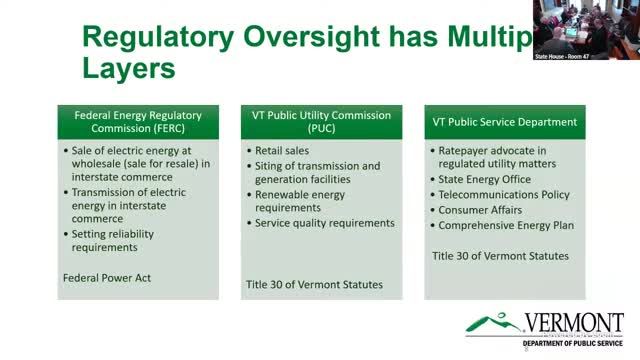
This article was created by AI using a video recording of the meeting. It summarizes the key points discussed, but for full details and context, please refer to the video of the full meeting. Link to Full Meeting
The meeting showcased a graph illustrating Vermont's electric rates, which have remained consistently lower than those of other New England states and New York. This stability is attributed to Vermont's unique regulatory framework, where utilities manage all aspects of electric service—from generation to transmission and distribution. Unlike states with retail choice, where customers can select their power suppliers, Vermont's model allows utilities to secure long-term contracts, insulating them from the volatility of short-term market fluctuations.
The committee noted that while global events, such as the 2022 invasion of Ukraine, have driven energy prices up across the globe, Vermont's rates did not experience the same dramatic spikes. This resilience is largely due to the state's utilities being hedged between 85% to 95%, meaning they have pre-arranged contracts that cover their energy supply. These contracts vary in length, with some extending up to 20 years, allowing Vermont to weather market storms more effectively than states reliant on shorter-term agreements.
However, the discussion also acknowledged that as these long-term contracts expire, Vermont could still face upward pressure on rates, depending on prevailing market conditions at the time of renewal. The committee members expressed a desire to understand how Vermont's situation compares to the rest of the country, noting that while New England generally has higher rates, regions like the Pacific Northwest benefit from abundant hydroelectric resources, resulting in lower costs.
As the meeting concluded, it became clear that Vermont's approach to energy regulation not only fosters stability but also positions the state as a model for managing energy costs amid global uncertainties. The implications of these discussions are significant, as they highlight the importance of regulatory structures in shaping energy affordability and reliability for residents.
Converted from House Energy and Digital Infrastructure - 2025/01/29 - 10:00am meeting on January 29, 2025
Link to Full Meeting
Comments
View full meeting
This article is based on a recent meeting—watch the full video and explore the complete transcript for deeper insights into the discussion.
View full meeting